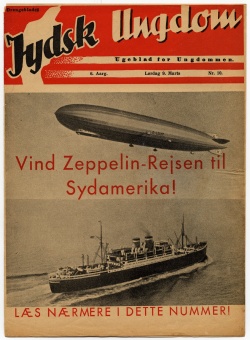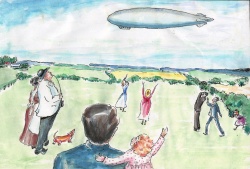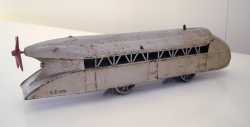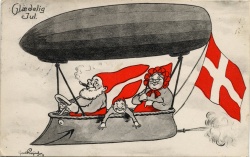Fascination goes on
01. Aug. 2006

Front page from boy's magazine "Jydsk Ung-dom" [Jutland Youth] of the 1930's. Private property.
Zeppelin-mania
When the zeppelins made their entry, an entire zeppelin industry soon flourished. Businessmen were not slow to understand that the interest was just as big no matter if people could afford a flight or not. Everything from zeppelin savings boxes, toy zeppelins, and Christmas decorations to pipes shaped as zeppelins were for sale, and people bought collector's items with all their might. To the majority it was the closest they would ever get to a real zeppelin.
Ingenuity was great when it came to production of collector's items and the wide selection gives evi-dence of the big role the zeppelins were playing in the dreams and consciousness of many people. If you are looking at the front pages of several maga-zines for boys of the 1930's, it is easy to imagine how many boys' dreams were shattered when they did not become the lucky winners of the main prize of the competition which was a trip by Graf Zeppe-lin. By the way, the trip was won by the then 15-year-old Karl Johan Søndergaard from Thisted.

Graf Zeppelin over Styding in 1931. Drawn by Anna Maria Michaelsen Ghaibeh.
Illustrators were amused at people's enthusiasm, and family members were on a large scale con-gratulated at birthdays and high festivals by post-cards featuring zeppelin motifs. Even before Hansa visited Copenhagen in 1912, postcards had been produced for the occasion:
Postcards were sold at the airfield and a lot of people were writing to friends and family in Ger-many, literally off the cuff. (Danish newspaper Berlingske Tidende, 20th September 1912).

Toy model of Schienenzeppelin. Belongs to Zeppelin Museum Friedrichshafen GmbH.
An Inspiring Shape
The Maybach Company, a producer of engines for among other things zeppelins and cars, was a pioneer with regard to the use of the aerodynamic shape, and the company was among the first to make tests in a wind tunnel in order to improve and develop the propulsion and speed of various means of transport. The German Franz Krucken-berg was inspired by the aerodynamic shape and technique of the zeppelin and tried to unify it with train working. The train was called a "Schienenzeppelin" - i.e. a rail zeppelin. However, it never be-came more than a prototype. It never went into production, but it was a part of the entire industrial wave inspired by the shape of the zeppelins, which could be seen reproduced in cars, motorbikes, crash helmets, and trains, just to mention some examples.

Christmas card designed by Carl Røgind in 1909. Private property.
A Lasting Impression
The enthusiasm was enormous. It may, of course, seem childish that a whole town is on its feet to see an "ordinary airship". But how many had seen such a sight before? And how many will ever see it again?
The above quotation from the newspaper Horsens Avis of 15th May 1931 accentuates the overall en-thusiasm for the zeppelins. To see a zeppelin float by was absolutely not an everyday occurrence. If you were one of the lucky who was in the right place at the right time, it was something that made such a great impression that it was never again forgotten.
Anna Maria Michaelsen Ghaibeh was three years old when Graf Zeppelin was on its journey around the North Sea in 1931. Today, 75 years later, the event still remains completely clear to her - as a mat-ter of fact it is her earliest recollection. To the delight of her children and grandchildren Anna Maria has written her memoirs, and although she is living in Syria, the news of the special exhibition at Post & Tele Museum reached her with the result that we can now all benefit from her fine childhood memory:

Toy model of the English airship R101. Belongs to Zeppelin Museum Fried-richshafen GmbH. Photo: Jan Friis
... suddenly somebody shouted: "Come out and see a zeppelin!" I was only three years old and had no idea what a zeppelin was, but I ran out into the yard together with the others.(...) Uncle Hans lifted me up and carried me on his arm and we followed the others out into the field be-hind the farm. Everybody helped each other to get through the fence as quickly as possible. "Look!" said uncle Hans and pointed his finger at the sky. And then I saw it, the zeppelin. They told me that it was an airship. And it was actually like a gigantic silvery ship in the air. High above the fields and the forests it was quietly and slowly gliding across the sky.

Christmas ornament. Belongs to Zeppelin Museum Friedrichshafen. Photo: Jan Friis.
The exhibition "The Airship is Coming!" can be seen on 4th the floor of Post & Tele Museum until 22nd October 2006.
This article may be copied or quoted with MuseumsPosten, Post & Tele Museum as source.
Comment this article
Only serious and factual comments will be published.